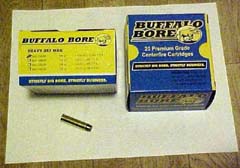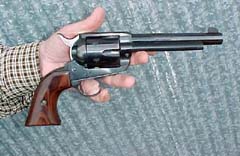|
In
2003, Buffalo Bore announced their development of a new
180 penetrator load for the .357 Magnum. Running at standard
pressure, it is advertised as launching a hard cast 180 grain
SWC at 1400 ft/sec out of a revolver.
Discussion with Buffalo Bore’s owner Tim Sundles
disclosed his intention in releasing this ammunition. Persons
living in bear country, while no doubt better served for
personal protection by handguns larger than .357, frequently
carry these light and convenient handguns - a Smith &
Wesson Model 19 is certainly more packable than a .45 Ruger
Redhawk. Add to this a huge number of leverguns in the same
caliber, and it becomes apparent that lots of people in bear
country are carrying .357s, adequate or not.
So Tim set out to develop the most effective bear ammo possible
for these guns. He was able to accomplish this primarily because
of an undisclosed new, non-canister powder. Whatever it is, we
also found it to be quite clean burning.
Reason enough, but those of us living in the Midwest couldn’t
help but also think of the further possibilities a really heavy,
tough bullet offered wild pig hunters. Plus, being a
standard pressure load, it shouldn’t excessively beat up those
smaller guns-like those K frames.
The Heavy .357 Magnum
Offered in 20 round packaging, the ammunition is loaded into
unplated Starline cases. The
bullets are very clean, sharp pieces of casting, and are deeply
crimped - and with good reason. These things kick in revolvers.
The heavy .357s are offered direct from Buffalo Bore, and with
considerable recoil for the caliber, and a cost before shipping
of around a dollar a round, it would do well to examine the
performance of the cartridge.
We took 3 guns to the range with 60 rounds of ammunition, and on
a bright but chilly February morning, we did some testing of the
stuff. The first 2, a single action revolver common on the used
market, and a new and compact lever action carbine, we felt
represented the sorts of guns backpackers and fly fishermen in
bear country might be expected to carry. The third, a single
shot, was chosen for a more thorough evaluation of the velocity
and accuracy potential of the load.
Hawes (J P Sauer) Western Marshall Single Action Revolver
A late ’60s import, this is dimensionally about equal in size
to a 5 ˝ inch Ruger Vaquero. With a 6" barrel, it weighs
in at a full 46 ounces. The test gun has rather loose, sloppy
chambers, and an equally loose firing pin bushing. Firing pin
strikes on Winchester 125 grain ammo shows large deep strikes.
For some reason, likely either softer primer cups or higher
pressure, the Buffalo Bore ammo, tended to flow primers somewhat
around the firing pin, and this occasionally tied the revolver
up. Since neither of two newer long guns showed any similar
problems, we chalk this up to a failing of the gun. Nonetheless,
we wouldn’t use this gun with this ammo.
That aside, firing the Heavy stuff also yielded a heavier recoil
than expected with .357. You forget with this load you have BOTH
bullet weight and velocity. This load produces similar
velocities to 125 grain Winchester, but with a 180 grain
payload.
|
WINCHESTER
125-grain .357 Magnum, Hawes revolver |
| Velocity (fps)
|
|
Buffalo Bore 180-grain .357 Magnum,
Hawes revolver |
| Velocity (fps)
Average 1508 fps - Standard Deviation 18.4 |
This revolver was never zeroed for any load by previous owners.
The front sight is massively tall, and the targets showed groups
8 inches low at 50 yards. Correcting this would be matter of
carefully filing the top of the front sight. It printed almost
exactly on for deflection, and grouping was a really satisfying
1.6 inches.
This test revealed 3 things. Older guns should be tested for
reliability with any high performance ammo-this one didn’t do
well. Second, be advised that Newton’s Laws have not been
repealed, and this gun produced .44 Magnum-like recoil,
controllable but more than with any previous factory ammunition.
Third, accuracy was much better than needed for the last ditch
application envisioned. This accuracy showed up with every gun
we tried it in.
Winchester ‘94 Ranger Compact
Representative of a multitude of Winchester, Marlin
and Rossi guns in this caliber, the no-frills 16"
barreled Trapper-length levergun was a real surprise. Well made,
finished, and good feeling, it shows reassuring feedback that
Americans are building quality guns in 2004.
A new gun, Buffalo Bore was the second load ever fired in this
little carbine. By no means even broken in, the Buffalo Bore
fed, ejected, and other wise functioned perfectly.
A 5 round chronograph string produced the following velocities:
|
Buffalo Bore 180-grain .357 Magnum,
Winchester '94 Ranger Compact |
| Velocity (fps)
Average 1847 fps - Standard Deviation 71.6 |
Grouping
over buckhorn iron sights was a surprising 1.25" inches,
again for a 5-shot group. What this little levergun would do
with a low powered scope or aperture sights is open to
conjecture, but what it did, as is, impresses well enough.
Recoil was certainly higher than with other ammunition, but
entirely tolerable for most shooters.
New England Firearms Handi-Rifle
Author Church hauled out his 22" barreled single shot,
partly because it had grouped well in the past with Winchester’s
180 grain .357, the Partition Gold, and partly to get
chronograph readings out of a longer barrel.
The velocity readings were surprising in that they were not much
faster than the Winchester with almost 6 inches less barrel.
|
Buffalo Bore 180-grain .357 Magnum,
New England Firearms Handi-Rifle |
| Velocity (fps)
Average 1884 fps - Standard Deviation 47.2 |
This
barrel long ago showed a liking for heavier .357 bullets with
the 180 Winchester load. It will group, over good aperture
sights, to 1.5 inches at 100 yards. This one won’t equal that
out of this gun, but still will cluster 5 rounds at 50 yards an
inch apart. This is more than is needed for the purpose, much
more.
Long ago Author Fortis’ father, and author Church attempted to
improvise a load to serve the same purpose as the Buffalo Bore
load. Over a stiff charge of 2400, we loaded a 180 Speer semi-spitzer
intended for the .35 Remington T/C Contender. We got a
very long loaded round suitable only for single shot guns, and
giving middlin’ accuracy at best.
|
180-grain Handload, T/C Contender |
| Velocity (fps)
Average 1535 fps - Standard Deviation 43.7 |
Clearly
this is no competition for Buffalo Bore’s off-the-shelf load.
Penetration Performance
Folk wisdom has long equated bone as being about as tough as
seasoned hardwood. Lacking a bear to shoot, we resorted to this
old test medium, and fired at 15 feet or so into year old dried
oak firewood. Not much difference here, despite velocity. Not an
inch in overall penetration separated the guns. The bullets were
grossly deformed, but deflected fairly little, and did not
fragment. This gives us fair confidence about what it would do,
if need be, to the skull of a brown bear.
Conclusions
The Buffalo Bore heavy .357 is high quality, high performance
ammo. We were highly impressed by the velocities (exceeding
claims, even out of a handgun), the accuracy (far more than
needed for close in bear defense) and cleanliness of the
cartridges. It should be born in mind that this ammunition is
for modern guns in fine mechanical order, and handgun shooters
should be prepared for a new class of .357 recoil.
Check out Buffalo Bore on the Web at: www.buffalobore.com.
Miles
Fortis & A K Church
  
Follow-up:
Buffalo Bore 180 .357 Heavy in the Hawes Revolver
by
Miles Fortis and A K Church
17th
May 2004
In our earlier Gunblast workup on the 180
grain heavy .357 magnum load, we reported really good accuracy
and iffy reliability out of the Hawes (J P Sauer
made) single action revolver.
These reliability problems were pretty
specific. Primers pushed into the firing pin bushings on the
venerable import, and this tied up rotation. This problem was
not present in any other gun, and subsequently Church's Herter's
Powermag .357, another ageable J
P Sauer item, has duplicated this once with Winchester 125 grain
ammo.
In Email conversation with Buffalo Bore ramrod
Tim Sundles, he revealed that he'd already had second
thoughts about primer toughness. So, subsequent lots of the 180
grain penetrator have a new, silver colored primer.
Many delays prevented timely follow-up after
receipt of the newer ammo, but today we were finally able to
retest it in the same gun.
Basically, it is more efficient to state what
didn't happen: the primers did nothing but ignite the powder,
the accuracy didn't come to any less than the really good
previous experience, and reliability failed to disappoint. It
just went off, still with impressive recoil, but no hang-ups
whatsoever.
It
was good ammo before, with this one odd exception. It would
appear it is now better ammo.
Miles
Fortis & A K Church
  
Got something to say about this article? Want to agree (or
disagree) with it? Click the following link to go to the GUNBlast Feedback Page.
All content © 2004 GunBlast.com.
All rights reserved. |
|
Click pictures for a larger version.

Buffalo Bore's new 180-grain .357 loads make the .357
Magnum a viable proposition against bear & boar.

Hawes Western Marshall SA revolver
proved to be very accurate with the Buffalo Bore load, but
reliability was a concern.
|
![]()